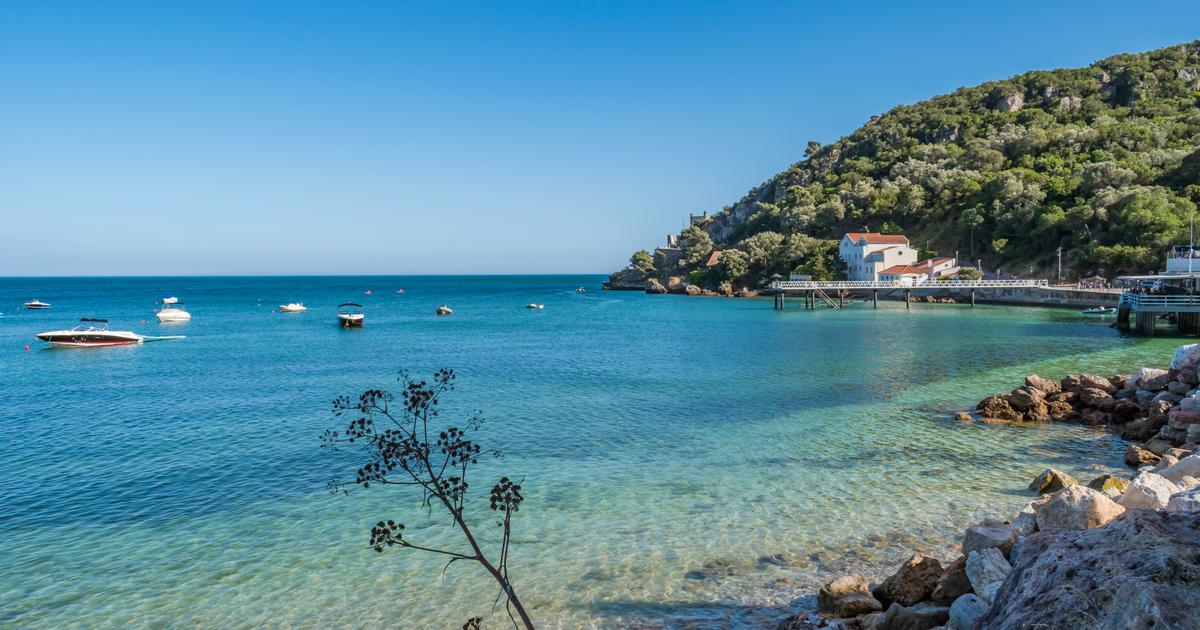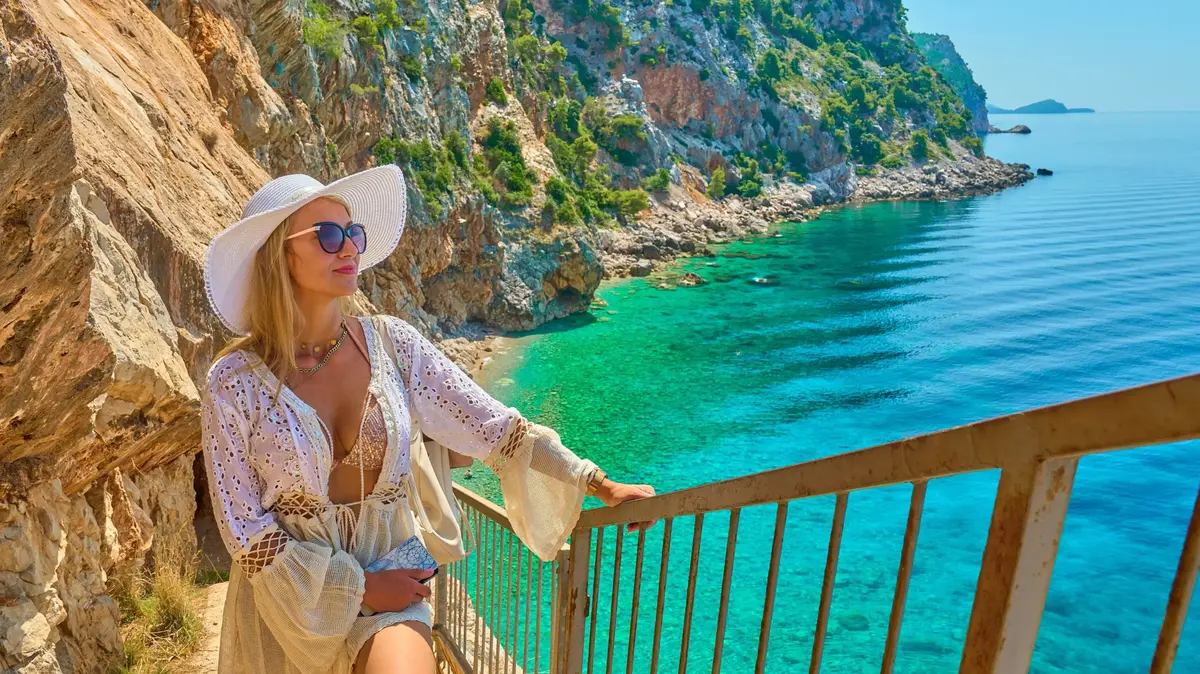Portugal continues to attract travelers in search of a generous mercury, unspoilt landscapes and an art of living that seems to stand the test of time. How to escape the crowds in the middle of summer? The answer with our selection that takes the side roads.
To discover
- Podcast Elsewhere: Singapore's hidden surprises and treasures
- Trips to Portugal: tours, hotels and tailor-made stays from our partners
- Partner stay Portugal | 8 days | Cruise in the Douro Valley
See alsoFive secret beaches in Portugal to enjoy holidays away from the crowds
Lisbon region: jungle bath in Sintra, and nature bath in the Serra da Arrábida
Impossible to miss the Pena National Palace, a must-see in the Sintra region. Jose Ignacio Soto / Adobe Stock
Both destinations are all close to Lisbon, so why deprive yourself of it?
First you have to discover the Serra da Sintra and its charming seaside town, just 30 kilometers from the capital. You could easily spend a week without getting bored in Sintra and its natural and architectural treasures, between green hills, neo-Gothic castles such as the Palácio da Pena, beaches... The Serra de Sintra (which rises to 529 meters), is a tropical and dreamlike jungle bubble that offers an immediate change of scenery. Full of water and springs, Sintra emerges from the mist.
In summer, the temperature is a good ten degrees lower than in Lisbon. The Lisbon nobility, to escape the heat of the capital, came to go green here. The city loved artists and free spirits, each coming to pursue his dream, to build a palace or a madness, to plant a garden of rare and exotic species. Sintra is the result of a multitude of visions and dreams.
Read alsoSintra: palaces, castles... Our must-see sites to visit at the gates of Lisbon
Panoramas of the Serra da Arrábida. stock.adobe
Then, head to a wonder of Portugal, still untouched by mass tourism, the Serra da Arrábida, which offers some of the most grandiose panoramas of Portugal. A 45-minute drive from Lisbon, this natural park lends itself to a few hours or days in contact with the elements.
From Setúbal to Sesimbra, the Serra da Arrábida stretches over 10,000 hectares of a landscape in which adventurers, lovers of postcard beaches and hiking enthusiasts meet... Cypresses, pines and limestone cliffs plunge into the ocean on the northern slope of Arrábida, vineyards, orchards and olive trees slide on its southern slope. A good reason to turn your back on Lisbon for a green (and blue) getaway, because the ocean is never far away).
Read alsoSerra da Arrábida, our must-sees of the sumptuous natural park of Portugal
North: Serra da Estrela, Portugal mountain atmosphere
The waterfalls of Poço da Broca. Zdenek Matye¡e¡ / stock.adobe
Certainly, Portugal is oceanic. And in this narrow country, the sea is never far away. But in the northern center, in the Serra da Estrela (the "mountain of the star"), which hosts the only ski area in the country, the ocean seems to be the end of the world. Because here we rub against the mountain and not just any, the roof of mainland Portugal (1993 m).
The terrain lends itself to exploration at the crossroads of waterfalls (such as Poço do Inferno, in Manteigas, and Poço da Broca, in Seia), natural pools (such as those in the village of Cortes da Meia), schist villages and viewpoints opening onto the steep slopes of the cliffs of the Serra and gently sloping pastures.
Beyond that, the Serra da Estrela also allows you to get acquainted with wool craftsmanship rooted in the industrial history of the region. In Vila de Manteigas, an abandoned nineteenth-century wool factory was rebuilt in 2011 by Burel. Renamed Burel Factory, this space houses looms, on which wool and burel, typical of the region, are worked. The tradition is preserved, honored and updated with ingenuity.
See alsoJourney to the heart of the Serra da Estrela, the path of the stars
Alentejo: from the tables of Evora to the last border of Marvão
The citadel of Marvão at 860 meters above sea level in the Natural Park of the Serra de São Mamede, on the border with Spain. Adobe Stock
South of Lisbon, the Alentejo cultivates the delicate art of distilling time. From Évora to Monsaraz, this region, which stretches from the Spanish borders to the coast, covering more than 31,500 km², lends itself to contemplation and the joys of the terroir, in slow mode.
The pleasure is undoubtedly on the plate if the journey begins in Evora, the city-museum that has just launched the preparations related to its status as "European Capital of Culture 2027". The city in the heart of Alentejo, did not wait for this distinction to give pride of place to the plate, products and typical recipes from the four corners of the region.
From açorda (fish soup) to Alentejano gazpacho, from cuts of meat (black pork, roast lamb) to conventual delights, traditional cuisine served in generous portions can be enjoyed for example at the Fialho table, a well-known gastronomic stop in the region.
Read alsoFive good reasons to discover Évora
Evora, which will be "European Capital of Culture" 2027. Antonio ciero
To discover a cuisine that honors the classics of the local repertoire while modernizing them, it will also be necessary to include the Cavalariça restaurant in its itinerary. In the shade of a bougainvillea in the paved courtyard of a private palace or inside, in the sunny setting signed Jacques Grange, it is time for tradition "à la sauce Cavalariça". Chef Bruno Caseiro, already at the piano of Cavalariça Comporta, plays classics from the region here and awakens them with a creative interpretation made from local ingredients. A success!
Finally, Tua Madre is an excellent pocket table where Italian cuisine meets the flavors of the Alentejo. The carbonara is infatuated with black pork cheek, mackerel invites itself in a panzanella salad and natural wines travel between La Botte and Portugal. Remember to book in advance of your visit.
The journey can then take height by heading for the fortified village of Marvão. On the other side, it's Spain! From the impregnable citadel of the hilltop city of Upper Alentejo, at 860 meters above sea level in the Serra de São Mamede Natural Park, the Spanish lands stretch as far as the eye can see. You are in the center of Portugal in one of the most beautiful villages in the country, a fierce bastion.
Everything speaks of Portugal's struggle to defend its border (the Raia) against the sworn enemy of the time, Spain. Along this line, a succession of fortified villages tells this story.
Read alsoThe ten most beautiful villages to visit in Portugal, from Piodão to Monsanto
Algarve: explore Faro and Olhão, 'archi' atmosphere, fishing port and lagoon
The charm of Faro, on the land side, and the exploration of the coastal lagoons of the Rio Formosa, on the sea side: a beautiful program. Sopotnicki
The Algarve is a long horizontal strip that stretches due south at each end of the country like an azure ribbon, from Cape St. Vincent in the west to the Andalusian border in the east. So from the tonic and stormy Atlantic, to a Mediterranean hinterland with salt marshes, islands and languid lagoons.
First stop: Faro. Too often, travellers only know Faro about the arrival hall of the airport, a mandatory passage before reaching other latitudes in the Algarve, including some of the most beautiful beaches in the country, such as those of Lagos or Praia da Marinha. The time has come to give the capital of the region a chance again by taking an interest in its architectural heritage. Because, under the impetus of the architect Manuel Gomes da Silva (1921-2016) and his disciples, Faro became a reference of modernist architecture.
Read alsoWhat are the best beaches in the Algarve? Our most beautiful or confidential
We learn the particularities of this style during a walk led to the four corners of Faro by a French couple passionate about architecture, settled here for several years. From facades to balconies, from azulejos to cobogo, Faro reveals another profile, between art deco and regional modernism... To gain height and toast the roofs, head for the bell tower of Faro Cathedral where you can embrace the city and the Ria Formosa with a single glance.
Lagoons of the Ria Formosa. Heinz Schulte
10 km from Faro. Olhão, fishing port and small white town slams on the blazing sun. We laze on the terrace on the roofs, we stroll through its alleys, we take fishing boats to reach the islands, tongues of virgin sand set between sky and sea in the Natural Park of the Ria Formosa.
How to discover the Ria Formosa
You can glide on the waves of the Ria Formosa in the company of a marine biologist, to tame the fauna and flora of this reserve of protected coastal lagoons, of 18,000 m2.
See also - What are you allowed to pick up on the beach?
This article is being updated











/cloudfront-eu-central-1.images.arcpublishing.com/prisa/KMEYMJKESBAZBE4MRBAM4TGHIQ.jpg)


